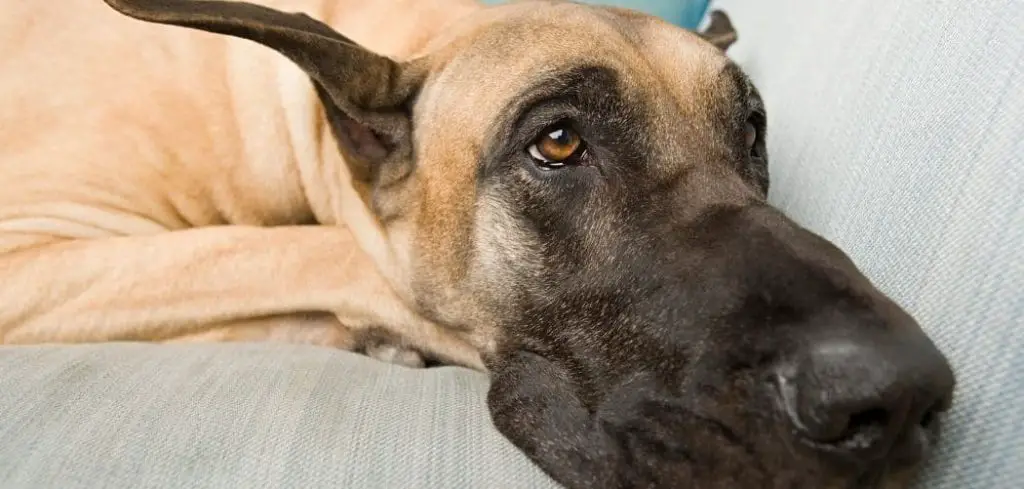If your Great Dane is suddenly pooping in the house, it can be frustrating and concerning.
Great Danes are known for their intelligence and trainability, so when they start having accidents indoors, it often signals an underlying issue.
We will explore the possible reasons your Great Dane is pooping in the house and provide actionable solutions to help you resolve this behavior.
Common Reasons Your Great Dane Is Pooping Indoors

1. Medical Issues Causing Indoor Accidents
One of the most important things to rule out first is a medical condition. If your Great Dane is experiencing gastrointestinal distress, they may not be able to control their bowel movements.
Possible medical causes include:
Diarrhea or loose stools due to dietary changes, food allergies, or infections.
Inflammatory bowel disease (IBD), which can cause frequent and urgent bowel movements.
Parasites such as worms that cause digestive upset and irregular bathroom habits.
Aging-related incontinence, where senior Great Danes lose bowel control due to weakening muscles.
Solution: If your Great Dane is pooping in the house suddenly and frequently, consult your veterinarian to rule out health problems.
2. Improper House Training or Reinforcement Issues
Even if your Great Dane was successfully house-trained, they may regress if their training wasn’t reinforced consistently.
Signs of incomplete training:
Your Great Dane only eliminates outside when supervised.
They have accidents in the same areas inside the house.
They don’t signal when they need to go out.
Solution: Reinforce potty training by rewarding your Great Dane for eliminating outdoors. Use a consistent schedule and praise or treat them when they poop outside.
Related: Why Does my Great Dane Have Incontinence?
3. Anxiety and Stress-Related Pooping
Dogs, including Great Danes, can experience anxiety that leads to accidents indoors.
Common triggers for stress-induced pooping:
Separation anxiety when left alone for long periods.
Changes in the household, such as a new pet, a baby, or moving to a new home.
Loud noises like thunderstorms or fireworks.
Solution: Identify stress triggers and help your Great Dane adjust. Provide plenty of exercise, enrichment, and a safe space where they feel secure.
4. Dietary Issues and Sudden Food Changes
Diet plays a significant role in a dog’s bowel habits. A sudden change in food can cause digestive upset, leading to accidents indoors.
Common dietary culprits:
Switching to a new food brand too quickly.
Feeding low-quality dog food with fillers and artificial ingredients.
Overfeeding or feeding too many treats.
Solution: Gradually transition your Great Dane to new food over 7-10 days. Provide high-quality, digestible ingredients, and avoid abrupt dietary changes.
5. Lack of a Consistent Bathroom Schedule
Great Danes thrive on routine. If your dog isn’t taken outside at regular intervals, they may be forced to eliminate indoors.
Signs of an inconsistent schedule:
Pooping at random times.
Holding bowel movements too long, leading to accidents.
Solution: Establish a structured bathroom schedule, taking your Great Dane outside at the same times every day (e.g., morning, after meals, before bed).
6. Aging and Mobility Problems
As Great Danes age, they may experience joint pain or mobility issues that make it difficult to reach the door in time.
Common age-related issues that lead to accidents:
Arthritis or hip dysplasia making movement painful.
Cognitive decline causing disorientation.
Loss of bowel control due to weakened muscles.
Solution: Provide orthopedic bedding and easy access to the yard. Consider installing ramps or using doggy diapers if necessary.
7. Scent Marking and Territory Behavior
Though less common than with urination, some dogs use feces to mark their territory, especially in multi-pet households.
Solution: Clean accidents thoroughly with an enzymatic cleaner to remove lingering odors that may encourage repeat incidents.
How to Stop Your Great Dane from Pooping in the House
If your Great Dane is pooping indoors, follow these steps to correct the behavior:
Step 1: Rule Out Medical Problems
A vet visit is essential to ensure there are no underlying health issues. If your Great Dane is experiencing digestive issues, infections, or age-related incontinence, your veterinarian can recommend appropriate treatments such as medication, dietary adjustments, or supplements. Ignoring potential medical causes can prolong the problem and lead to further complications.
Step 2: Reinforce Proper House Training
Even if your Great Dane was house-trained before, occasional refreshers are necessary. To reinforce house training:
Take your Great Dane outside frequently, especially after meals and naps.
Use positive reinforcement such as treats and praise immediately after they poop outside.
Keep them on a leash in the house to monitor their behavior and prevent sneaky accidents.
Use crate training if needed, as dogs naturally avoid soiling their sleeping areas.
Related: Why is my Great Dane sad?
Step 3: Address Anxiety and Stress
If anxiety is causing your Great Dane to poop in the house, addressing their emotional well-being is crucial:
Provide plenty of physical and mental stimulation through exercise and interactive toys.
Establish a predictable daily routine to help them feel secure.
Use calming aids such as pheromone diffusers, anxiety wraps, or CBD treats.
If separation anxiety is a concern, gradually desensitize them to being alone by practicing short departures and rewarding calm behavior.
Step 4: Maintain a Strict Feeding and Bathroom Schedule
A consistent routine can help regulate your Great Dane’s digestion and prevent accidents:
Feed your Great Dane at the same times every day to establish a predictable bathroom schedule.
Take them outside for potty breaks at regular intervals, including first thing in the morning, after meals, and before bed.
Monitor their stool consistency and adjust their diet if necessary to promote firm, regular bowel movements.
Related: Great Dane diarrhea and not eating (Here’s why)
Step 5: Thoroughly Clean Indoor Accidents
Dogs have a strong sense of smell, and lingering odors can encourage repeat accidents in the same spot. To prevent this:
Use an enzymatic cleaner to break down waste odors completely.
Avoid using ammonia-based cleaners, as they can mimic the smell of urine or feces and attract your dog back to the area.
If your dog has a favorite “accident spot,” consider blocking access to that area temporarily.
Step 6: Monitor for Behavioral Triggers
Keeping a journal of your Great Dane’s accidents can help identify patterns and underlying causes. Take note of:
The time of day accidents occur.
Changes in their diet, routine, or environment.
Signs of stress or anxiety before they poop indoors.
Any inconsistencies in their potty training routine.
By identifying triggers, you can proactively address potential causes and prevent future accidents.
Step 7: Seek Professional Help if Needed
If your Great Dane continues to have accidents despite your best efforts, a professional dog trainer or behaviorist can help:
A trainer can assess your Great Dane’s potty training progress and provide customized strategies.
A behaviorist can address anxiety-related issues and develop a plan to reduce stress.
Your veterinarian may recommend medication or dietary changes if medical issues persist.
Key Takeaway
If your Great Dane is pooping in the house, don’t panic! By understanding the possible causes—whether medical, behavioral, or environmental—you can take proactive steps to correct the issue. Remember to be patient, consistent, and positive while working on a solution.
